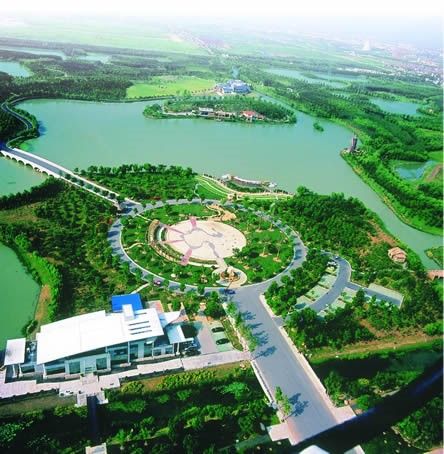Urban Parkland Upgrade to Multifunctional Water Treatment and Flood Management Asset (Case Study)
Published on by Water Network Research, Official research team of The Water Network in Case Studies
Forest Park Ecological Wetland
Location : Kunshan, Jiangsu, China 
Participants : E2DesignLab, CRCWSC, Kunshan City Construction, Investment and Development Company (KCID), Suzhou Garden Design Institute
Topics : Flood resilience, Ecosystem health, Stormwater treatment, Water sensitive parks and open spaces
Project description
Built in 2001, the Kunshan Forest Park is a National Urban Wetland Park covering an area of 166 hectares in the northwest of Kunshan city in Jiangsu province, China. The Forest Park boasts an array of eco-tourism resources and is characterised by parklands, forests and lakes.
The ecological wetland project aims to improve the water quality of five large park lakes by transforming traditional green space into multifunctional green infrastructure which provides water treatment, water recirculation, and extra flooding storage within a versatile landscape. In addition, an ecological restoration zone is planned to protect and remediate the local aquatic and terrestrial habitat, restoring the ecological values and encouraging flora and fauna back to the area.
Woody debris enhances fish breeding habitat
The Drivers: Improve waterway quality for enhanced community wellbeing and environmental health
Kunshan is a polder (a piece of land in a low-lying area that has been reclaimed from a body of water by building dikes and drainage canals) city, meaning it is a low-lying area enclosed by dikes, with no connection to other groundwater sources, except through diverted rivers or engineered canals. Polder waterway quality can be poor and flooding can be an issue in some areas of the city. A strategy was developed to help address this issue by integrating constructed wetlands into precinct parklands to enhance water quality. Canal water would be recirculated through constructed wetlands for treatment, creating a series of open cells within the polder waterway network. The incorporation of these cells has also been used for greater floodwater protection by connecting them as emergency detention basins. The Forest Park Ecological Wetland has been undertaken as a trial to test this strategy.
The Innovations: Working demonstration of innovative flood management and water treatment approach to protect a growing population and its downstream aquatic environments
- Automatic flood relief: The lake system is hydraulically connected to an adjacent waterway by an active gate. If the polder reaches a critical flood level, the gate opens and allows for the Forest Park Lake system to act as additional storage for flood waters.
- Multifunctional landscapes: F orest Park wetlands have been designed to support both water quality treatment and passive recreation within a broader parkland setting.
- Polder water recirculation: Polder water is recirculated through constructed wetlands for greater waterway health.
- Improved ecological value of open space: The forest plantations within Forest Park were reviewed with the objective of enhancing their ecological value. One area within the park was found to support significantly greater bird life than other areas. This was an island that received no parkland maintenance. Pathway and visitation patterns were reviewed accordingly and areas adjacent to the high ecological value island were zoned for ecological enhancement, forming a large area dedicated to habitat and biodiversity. Pathways for pedestrians were downgraded, buffer planting was established, and any parkland style maintenance ceased to reduce disturbance.
- Fish breeding habitat creation: The lakes in Forest Park are mostly excavated waterbodies. Consequently, there is limited natural habitat diversity. The constructed wetland component of the project was going to result in some tree removal, so an opportunity was taken to use the removed trees as large woody debris in the lakes as enhanced fish habitat. Wood debris was carefully located to improve the littoral zone of the existing habitat island and to reduce wave action on the windward edge of the island.
Lessons
- Parklands can be designed to become multifunctional water management infrastructure, providing both filtration to improve water quality and flood water storage.
- Cleared trees can be utilised for habitat creation providing an important ecological resource while lowering disposal costs.
The Outcomes
1. Cities providing ecosystem services
- New urban wetlands: Lake-wetland system provides water cycling and purification.
- Biodiversity values: Forest enables nutrient cycling, pollination and the provision of habitat. There are over 60 varieties of wild animals, including otters and zibets, and approx. 10,000 migratory birds visit the park every year.
- Air purification: Park is considered a green lung for the city, because its forest coverage is as high as 95%.
- Climate regulation: Lake system and forest provide evaporative cooling.
- Sense of place: Precinct provides an aesthetic destination for spiritual and recreation activities.
2. Cities as water supply catchments
- City as a catchment: Lake system offers the opportunity for stormwater harvesting.
3. Cities comprising water sensitive communities
- Education: Park offers exhibitions of aquatic plants and animals and wetland purification activities.
- Knowledge: Park functions as a platform for science popularisation and research.
Business Case
Costs
- Total investment of 250 million yuan (AUD $52.3 million).
Benefits
- Enhanced eco-tourism. In 2013, Forest Park received a total of 1.8 million visitors.
- New opportunities for scientific research and implementation of innovative technologies.
- Greater flood resilience for the local area and confidence in new urban development.
- Increased waterway health.
- Cool sanctuary during heatwaves.
- Preserved habitat for local flora and fauna.
The case study was originally published by CRC for Water Sensitive Cities.
Find the full study attached below in PDF.
Media
Taxonomy
- Flood Management
- Wetlands
- Flood Modeling
- Constructed Wetlands
- Flood management
- Floating Treatment Wetlands